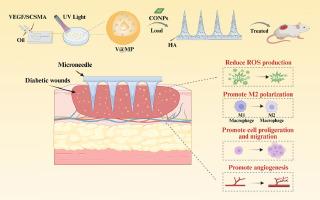A biphasic drug-releasing microneedle with ROS scavenging and angiogenesis for the treatment of diabetic ulcers
IF 9.4
1区 医学
Q1 ENGINEERING, BIOMEDICAL
引用次数: 0
Abstract
Diabetic ulcers are one of the common complications in diabetic patients. Delayed wound healing is associated with persistent pro-inflammatory M1 polarization, reduced angiogenesis and increased reactive oxygen species (ROS) in the microenvironment. Wound healing consists of multiple phases and therefore requires treatment tailored to each phase. In this study, a biphasic drug-releasing microneedle (MN) was fabricated to achieve early ROS scavenging and late accelerated angiogenesis to promote wound healing. Vascular endothelial growth factor (VEGF) was first encapsulated in methacryloylated sulfonated chitosan (SCSMA) microspheres (V@MP), and then V@MP was loaded into hyaluronic acid (HA) microneedles along with cerium dioxide nanoparticles (CONPs). Rapid dissolution of HA rapidly releases the CONPs to clear ROS, whereas the V@MP stays in the wound. SCSMA slow degradation prolongs the release of VEGF, thereby promoting angiogenesis. In vitro and in vivo studies have shown that this biphasic drug-releasing smart microneedle improves cell proliferation and migration, effectively scavenges ROS, promotes angiogenesis and tissue regeneration, and synergistically promotes M2 macrophage polarization. It provides a new delivery mode for nano-enzymes and growth factors that could be multifunctional and synergistic in the treatment of diabetic ulcers.
Statement of significance
In our study, we present a microneedle (V@MP/C@MN) that can release drugs biphasically, which showed good repair ability in diabetic ulcer model. Large amounts of CONPs were rapidly released to alleviate oxidative stress during the inflammation of the wound, and V@MP stayed in the wound for a long period of time to release VEGF and promote angiogenesis in the late stage of wound healing. The results indicated that V@MP/C@MN could promote cell proliferation and migration, effectively scavenge ROS, promote angiogenesis and tissue regeneration, and synergistically promote M2 macrophage polarization, which could play a multifunctional and synergistic role in the treatment of diabetic ulcers.

一种具有清除 ROS 和血管生成功能的双相药物释放微针,用于治疗糖尿病溃疡。
糖尿病溃疡是糖尿病患者常见的并发症之一。伤口愈合延迟与持续的促炎性 M1 极化、血管生成减少以及微环境中活性氧(ROS)增加有关。伤口愈合由多个阶段组成,因此需要针对每个阶段进行治疗。本研究制作了一种双相药物释放微针(MN),以实现早期清除 ROS 和晚期加速血管生成,从而促进伤口愈合。首先将血管内皮生长因子(VEGF)封装在甲基丙烯酰化磺化壳聚糖(SCSMA)微球(V@MP)中,然后将V@MP与二氧化铈纳米颗粒(CONPs)一起装入透明质酸(HA)微针中。HA 的快速溶解会迅速释放 CONPs 以清除 ROS,而 V@MP 则会留在伤口中。SCSMA 的缓慢降解可延长血管内皮生长因子的释放,从而促进血管生成。体外和体内研究表明,这种双相药物释放智能微针可改善细胞增殖和迁移,有效清除 ROS,促进血管生成和组织再生,并协同促进 M2 巨噬细胞极化。它为纳米酶和生长因子提供了一种新的传递模式,可在治疗糖尿病溃疡方面发挥多功能和协同作用。意义说明:在我们的研究中,我们提出了一种能双相释放药物的微针(V@MP/C@MN),它在糖尿病溃疡模型中表现出良好的修复能力。在伤口发炎期间,大量的 CONPs 被迅速释放以缓解氧化应激;在伤口愈合后期,V@MP 在伤口中长期停留以释放血管内皮生长因子并促进血管生成。结果表明,V@MP/C@MN可促进细胞增殖和迁移,有效清除ROS,促进血管生成和组织再生,并协同促进M2巨噬细胞极化,在糖尿病溃疡的治疗中可发挥多功能协同作用。
本文章由计算机程序翻译,如有差异,请以英文原文为准。
求助全文
约1分钟内获得全文
求助全文
来源期刊

Acta Biomaterialia
工程技术-材料科学:生物材料
CiteScore
16.80
自引率
3.10%
发文量
776
审稿时长
30 days
期刊介绍:
Acta Biomaterialia is a monthly peer-reviewed scientific journal published by Elsevier. The journal was established in January 2005. The editor-in-chief is W.R. Wagner (University of Pittsburgh). The journal covers research in biomaterials science, including the interrelationship of biomaterial structure and function from macroscale to nanoscale. Topical coverage includes biomedical and biocompatible materials.
 求助内容:
求助内容: 应助结果提醒方式:
应助结果提醒方式:


